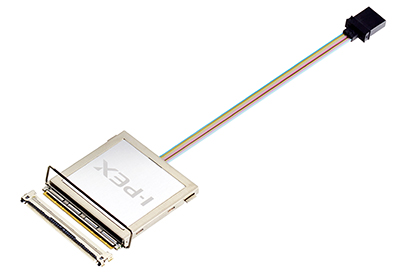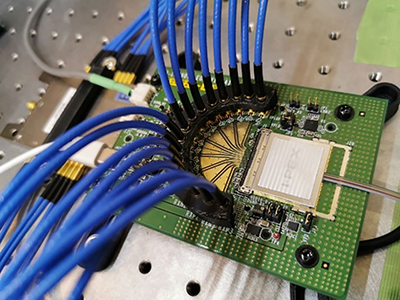Benefits of Using an On-Board Optical Modules in an FPGA Platform
Peng Cheng Laboratory's (PCL) article, "Verification of 100Gb/s Data-Rate Transceiving through Silicon-Photonic Module in an FPGA Platform," has been published on the IEEE (Institute of Electrical and Electronics Engineers) website.
PCL reported verification results of 100 Gbps transmission using an FPGA platform at the China Semiconductor Technology International Conference. I-PEX’s LIGHTPASS®-EOB 100G optical module is one of the components on the FPGA-based verification platform by PCL.
The results of PCL’s research have demonstrated the suitability of the newly created FPGA-based verification platform for characterizing high-speed data rates of 100 Gbps with 4×25G SerDes TX/RX.
https://ieeexplore.ieee.org/document/10219187
To download this information, registration with IEEE is required.

FPGA (Field Programmable Gate Array) is a type of integrated circuit (IC) used in telecommunications equipment, data centers, industrial equipment, and consumer electronics. FPGAs are integrated circuits that allow digital circuits (logic circuits) to be rewritten in the field.
FPGAs have advantages such as ease of specification modification and higher integration, which have been issues with conventional ICs and LSIs, and are becoming indispensable in the current digital technology era.
LIGHTPASS® is a series of multi-channel ultra-compact and thin optical module products designed for onboard optical applications. By enabling bidirectional optical communications (E-to-O, O-to-E), the electrical transmission length can be shortened, and the transmission loss can be significantly reduced.
In addition, I-PEX's LIGHTPASS® products have a wide operating temperature range. This feature ensures stable performance in areas where they are expected to be used in high-temperature environments, such as autoclave-compatible endoscope cameras, communication base stations, in-vehicle cameras, and LiDAR.

Reasons to use on-board optical modules on FPGA platforms:
High Processing Power and Flexibility
FPGAs are hardware-programmable devices capable of handling various applications such as convolutional operations, signal processing, and digital signal processing. By employing on-board optical modules, fast and flexible data transmission becomes achievable.
High Data Transmission Rates
Optical communication provides higher data transmission rates than electrical signals. Using on-board optical modules further enhances data bandwidth, allowing for the maximum extraction of processing performance.
Energy Efficiency
Optical communications, requiring less energy to transmit data compared to electrical signals, enables the construction of energy-efficient systems. Especially in environments like data centers and high-performance computing (HPC), improving energy efficiency is crucial.
Reduction of Electrical Noise
Optical communications is less susceptible to electromagnetic noise compared to electrical signals, leading to higher reliability. This results in improved data accuracy and ensures the stability of the system.
Miniaturization and Lightweight Design
Optical modules are relatively compact, and even with the same data transfer capabilities, optical communications generally enables the creation of smaller and lighter devices compared to electrical communication. This is particularly advantageous in portable devices and embedded systems.
For these reasons, utilizing on-board optical modules on FPGA platforms has the potential to bring various benefits, including high performance, low energy consumption, and improved reliability.
